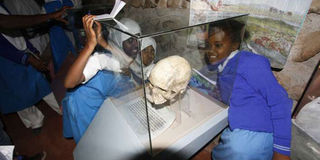Kariandusi: Where prehistoric human beings come to life

Pupils of Kongoni Primary School, South C, Nairobi, discuss the skull of a Homo Sapien at the Kariandusi prehistoric site in Gilgil, Nakuru County, on June 17, 2014. Kariandusi is on the Nakuru-Eldoret highway to the west of River Gilgil and is one of the most famous prehistoric sites in East Africa. PHOTO SULEIMAN MBATIAH | NATION MEDIA GROUP
What you need to know:
- Kariandusi is on the Nakuru-Eldoret highway to the west of River Gilgil and is one of the most famous prehistoric sites in East Africa.
- The Church of Goodwill still has its furniture intact. Its bell is also functional but is hardly used for its intended purpose.
Forget the primary school geography and history lessons on Kariandusi.
Let us focus on the rich history associated with this site.
Kariandusi is on the Nakuru-Eldoret highway to the west of River Gilgil and is one of the most famous prehistoric sites in East Africa.
It is on the Nakuru-Elementaita basin and is bordered by Menengai crater to the north and Mount Eburru to the south.
This as an excellent spot for evolution enthusiasts and family and school visits, as it portrays a vast array of stone tools used by early man.
The site, which is managed by National Museums of Kenya, lies next to Kariandusi Diatomite Plant and was discovered in 1928 by Dr Louis Leakey.
Archaeology lovers have a good time looking at the geological evidence showing the past existence of larger lakes in the area.
It is hundreds of metres higher than the present Lake Nakuru and Elementaita, which were once part of this basin.
But as the history tells us, a rise in the lake level drove prehistoric humans from their home.
This prompted them to bury their tools and weapons as they left in a hurry.
ATTRACTIVE SITES
This site, as the array of tools suggests, belonged to the Acheulian stage of the great hand axe culture.
Apart from the rich history and tools kept here, Kariandusi offers an excellent landscape with beautiful views of the Great Rift Valley and Lake Elementaita.
It hosts the Church of Goodwill, a historic church constructed in the 1940s.
Next to the church is a house built by a colonial settler, Lady Eleanor Balfor, as a gift to God for the safe return of her sons who were fighting in WWII.
The church, which is still being used, continues to attract visitors from around the globe.
The Church of Goodwill still has its furniture intact. Its bell is also functional but is hardly used for its intended purpose.
The site offers various attractions such as camping places, nature trails, a museum, caves and the monumental church building.




